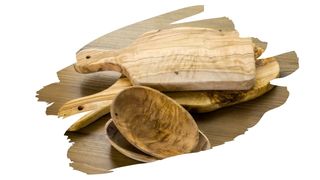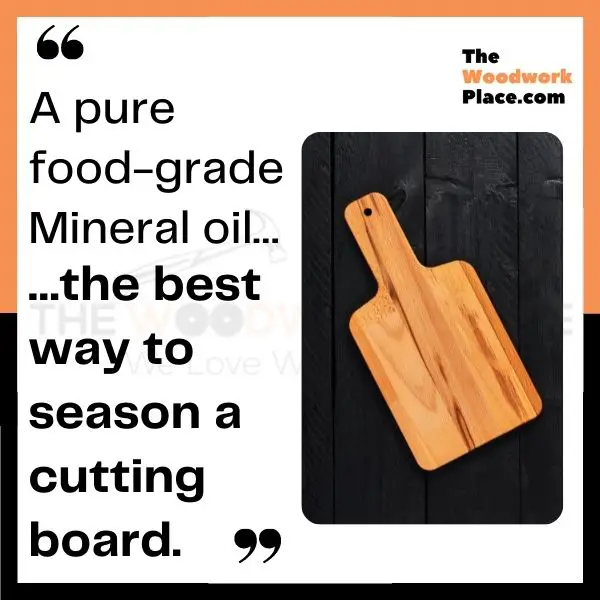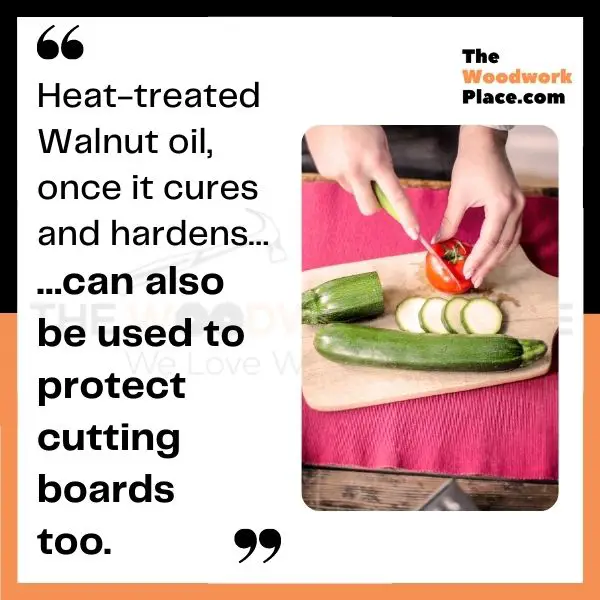When you oil a cutting board, the goal is to try and make that wood grain as water-repellent as possible. This is no small feat, least of all because wood fibers absolutely love to absorb liquids, water, and moisture like a sponge.
And once water gets into wood fibers, wood can warp, twist, rot and decay. So, what’s the best oil you can use to coat over a cutting board?
When it comes to cutting board oils, food-grade mineral oil is the absolute gold-standard. This non-drying oil will make wood water-repellent, preventing natural wood from soaking up raw meat fluids and water.
However, a drying Walnut oil can be a good alternative to mineral oil. We aren’t referring to the grocery store Walnut oil meant for culinary use here either. That version of Walnut oil is a non-drying oil typically used for cooking.
Instead, the type of Walnut oil used to season cutting boards is a heat-treated filtered version of Walnut oil. This heat-treated Walnut oil product will dry and harden into a solid resin coat when applied to cutting boards and butcher blocks.
What Kind Of Oil Should You Use On a Butcher Block? Use food grade mineral oil, one with no additives or extra ingredients.
But, is this drying oil really food safe enough to use on cutting boards, butcher blocks, and even wooden spoons?
Related Post: 4 Reasons Why You Should NOT Use Polyurethane On A Butcher Block
Well, in this post, you will learn the difference between a drying oil and a non-drying oil — and what that means for long-term cutting board upkeep.
You will also learn why raw untreated Walnut oil isn’t the best choice for your chopping block. So, let’s get started…

This post may contain affiliate links to products that we receive a commission for (at no additional cost to you). Learn more here.
What Is The Best Oil For A Wooden Cutting Board?
Mineral oil, (that is 100% food grade mineral oil), is the safest and most practical choice of oil for your cutting board.
This non-drying oil is made from distilled petroleum. And, as a non-drying oil, it does exactly that; mineral oil does not dry, cure, or harden.
There are other non-drying food grade oils, but you should never use them to season a cutting board. That is because these oils are sourced from edible food. And as such, oils such as vegetable oil or coconut oil, will only go rancid inside your chopping block.
Related Post: Walrus Oil Vs Mineral Oil: Which One’s Better For Your Cutting Board?
OK, So What Is Food Grade Mineral Oil (For Cutting Boards) Made From?
Food grade mineral oil is made from petroleum. However, that petroleum has been thoroughly filtered and distilled.
So, this particular type of mineral oil isn’t toxic. In fact, it’s safe even for consumption – although mineral oil is used as a pharmaceutical laxative, not as some kind of a cooking oil.
This wood oil will never dry and will always stay ‘greasy’ to the touch. However, mineral oil can be washed off.
So, as you regularly wash and disinfect your cutting board, all of the oil gets removed. This is why you need to reapply mineral oil onto a cutting board every 2-4 weeks.

What About Castor Oil? Is Castor Oil A Mineral Oil Too?
Castor oil is an oil product that has been extracted from plant seeds.
This vegetable oil is not at all like mineral oil (which comes from petroleum). And because it comes from a food source, Castor oil can go rancid.
Will Mineral Oil Darken The Natural Color Of A Butcher Block? Mineral oil doesn’t darken wood at all. It’s clear coat won’t change the color of wood.
So, Where Can You Buy Mineral Oil Wood Finish?
From any grocery store or pharmacy. Or, you can buy it online.
But, if you do buy your mineral oil online, make doubly sure you’ve purchased the colorless and odorless food grade version.
For example, a great pure mineral oil product can be found in Sanco Industries NSF Certified Food Grade Mineral Oil. This product is 100% pure, 100% food grade, and 100% made in the USA.
You can check out the latest prices for this mineral oil product over on Amazon here.
Are There Any Other Non-Drying Oils Similar To Mineral Oil?
If you use mineral oil for health and cosmetic reasons, then food-sourced oils can be used similarly.
But, if you are looking for an alternative non-drying oil that won’t decay and go rancid inside wood, mineral oil is pretty much your best option. Although you can use very refined versions of food-sourced non-drying oils too.
And, besides oils, you can use natural beeswax (or a beeswax/mineral oil blend) to seal your cutting board.
Related Post: 7 Surprising Advantages (And 6 Disadvantages) Of Wax Finishes On Wood
OK, So What Kind Of Oil Can You Use Instead Of Mineral Oil (On Wood)?
You can use a drying oil. Drying oils are oils that dry, cure and harden into a durable resin coat. Some popular drying oil choices are Linseed oil, and Tung oil.
Related Post: Can You Put Tung Oil On Maple Wood (For An Effortless Finish)?
Now, to be very clear here, when these oils are still in liquid form they are toxic. However once they have wholly cured, they become food safe.
So, if you use a drying oil on your cutting board, that oil must cure completely before you can start using it. And waiting around for oil to cure can take a while.
What Is The Difference Between ‘Dry’ And ‘Cured’? A dry oil coat has gone through an evaporation process turning it from liquid into a soft solid. A cured oil coat has gone through a chemical reaction that has turned it from a soft solid into a hard resin.
And therein lies the problem. Drying oils, (like Linseed oil, Tung oil and Walnut oil), take a very long time to cure.
What’s more, if you wash your cutting board often, that regular rinse will wash off even a cured oil finish. Especially as these drying oils aren’t waterproof. So, you will still need to reapply a drying oil repeatedly, (just as you would with mineral oil), onto a cutting board.
Now, a coat of mineral oil only needs 24-48 hrs before your cutting board is ready for use.
But with drying oils, you not only have to wait 1-2 days for the finish to dry, but also an additional 2-3 weeks for it to cure!
Basically, time-wise, it is simply more practical to stick to using non-drying oils on cutting boards and butcher blocks.
Related Post: Walrus Oil Vs Odie’s Oil: Which One’s Better For Your Cutting Board?

Right. So, Is Walnut Oil Similar To Mineral Oil?
Walnut oil isn’t a mineral oil, as it doesn’t come from petroleum.
Instead, this oil is sourced from its namesake, the humble Walnut.
Related Post: Walnut Oil Vs Linseed Oil For Wood (What You Really Need To Know)
Is Walnut Oil Good For Cutting Boards?
Well, the culinary walnut oil sold in grocery stores should not be used to season a cutting board. That is because this raw version of Walnut oil goes off.
Instead, you should be using specially heat-treated filtered Walnut oil as a wood finish.
And What Does Heat Treated Walnut Oil Do To Wood Exactly?
It will work very much like how pure Tung oil finish works on wood. And that is that this particular Walnut oil product will coat on clear, leaving behind a satin looking wooden surface after it cures.
Related Post: Can You Use Tung Oil On Cherry Wood? (Avoid These 3 Simple Mistakes)
Does Walnut Oil Darken Wood At All?
Once it has completely cured, Walnut oil covers wood in a clear satin food-safe coat that doesn’t darken wood like Linseed oil does.
At most, it will only darken wood in so far as any kind of liquid (including water) darkens wood. But it won’t darken wood further as it ages.
Can You Put Heat Treated Walnut Oil Over Mineral Oil? While they work best independently of each other, you can apply Walnut oil over mineral oil.
Is Walnut Oil A Drying Oil?
Heat-treated Walnut oil will dry, cure and harden – just like Tung oil or Linseed oil.
But heat-treated walnut oil is only food safe after it has cured. So, you must always wait for this oil to cure and harden before you begin using the cutting board.
This is unlike a mineral oil finished board, because mineral oil coated cutting boards are ready to use within 24hrs.
It bears mentioning that heat-treated walnut oil doesn’t present the same nut-allergy risk that culinary walnut oil does. However, that doesn’t mean it is risk free. The found proteins inside Walnuts, (proteins that are responsible for allergic reactions), are filtered out as part of the heat-treatment process. But, heat-treated walnut oil may still pose a minimal risk.
How Long Does It Take For Walnut Oil To Go Rancid?
The grocery store Walnut oil meant for consumption, (although typically used as a cooking oil), should not be used on wood. If you were to coat a bottle of this onto your cutting board, that wood would go rancid within 6 months.
Heat treated Walnut oil, however, has been filtered in such a way that this special wood finish will not go rancid at all. And, this should go without saying but, heat-treated Walnut oil should NOT be consumed.
So, Here Are The 3 Key Takeaways…
- A pure food-grade Mineral oil is the best way to season a cutting board.
- Heat-treated Walnut oil, once it cures and hardens, can also be used to protect cutting boards too.
- But, Mineral oil applications are easier to upkeep, compared to the slow-drying Walnut oil alternative.



